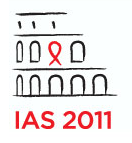Elvitegravir vs raltegravir: 48 week results in treatment-experienced patients
1 August 2011. Related: Conference reports, Antiretrovirals, IAS 6th Rome 2011.
Simon Collins, HIV i-Base

Elvitegravir is a once-daily integrase inhibitor being developed by Gilead. This was a double-blind, placebo-controlled study that randomised 702 treatment-experienced patients to compare elvitegravir (150 mg once-daily; reduced to 85 mg with atazanavir/r or lopinavir/r) to raltegravir (400 mg twice-daily), each with a background regimen of sensitive boosted-PI plus a third sensitive drug selected by phenotype (from NRTI, maraviroc, etravirine or T-20) and including the use of 3TC/FTC with the M184V mutation. The primary endpoint was proportion of patients with viral load <50 copies/mL at week 48 (TLOVR analysis, ITT), This was a non-inferiority study with the lower limit of the 95%CI set at 10%.
Baseline characteristics included mean age 45 years; 18% were women; mean CD4 count 260 cells/mm3 (45% with CD4 <200), median viral load ~ 20,000 copies/mL (with 26% >100,000 copies/mL) and approximately 5% and 15% of patients were coinfected with HBV or HCV respectively. Approximately 63% patients had primary resistance to two or more classes (PI 33%, NRTI 72%, and NNRTI 61%), balanced between arms.
Choice of background PI was largely darunavir (58%), lopinavir/r (19%) or atazanavir (16%). The third drug was an NRTI in 80% of patients (tenofovir 59%, tenofovir/FTC 27%, abacavir 4%, 3TC 3%, other 7%) with 13% using etravirine and 6% using maraviroc.
At week 48 a similar virological response rate was reported in each arm: 59% vs 58% in the elvitegravir vs raltegravir arms respectively which was strongly significant for non-inferiority (difference 1.1%; 95%CI: – 6.0% to +8.2%; p= 0.001). Approximately 20% of patients in each arm were reported as discontinuing due to virological failure: due to viral rebound (11% vs 16%) or never suppressing (8% vs 5%) in the elvitegravir vs raltegravir arms respectively with 1% or patients in each arm failing due to a switch of background drugs. A summary of virological and safety results is included in Table 1.
However, discontinuations in a following slide were reported at 24% in each arm, mainly due to non-adherence, loss to follow-up or withdrawn consent and are detailed in Table 2, with virological failure reported in only 9 patients in each arm.
| EVG n=351 | RAL n=351 | EVG vs RAL | |
|---|---|---|---|
| VL < 50 c/mL | 59% | 58% | 95% CI, -6.0%8.2%, p= 0.001 for non inferiority |
| Virological failure | 20% | 22% | |
| Discontinuations | 24% | 24% | |
| CD4 mean increase (on-treatment analysis) | +138 | +147 | |
| D/c due to AEs | 9/354 (3%) | 15/358 (4%) | |
| INI resistance | 16/62 (26%) | 15/76 (20%) |
| ELV n=351 | RAL n=351 | |
|---|---|---|
| Discontinuations | 85 (24%) | 83 (24%) |
| Non compliance | 21 | 17 |
| Lost to follow-up | 22 | 21 |
| Withdrew consent | 15 | 9 |
| Virological failure | 9 | 9 |
| Side effects | 8 | 12 |
| Death | 0 | 7 |
| Other (pregnancy or investigator decision) | 3 | 2 |
When looking at drug resistance in the patients with virological failure, this included 61 and 75 people in the elvitegravir and raltegravir arms respectively. In this dataset, failure with integrase-associated mutations was reported at a comparable number though with increased frequency (16/60; 27% vs 15/72; 21%) in the elvitegravir vs the raltegravir patients. Development of new PI- or NRTI-associated resistance was generally low and similar between the two groups.
Less than 5% of participants discontinued due to side effects. The only difference between arms in terms of adverse events was a higher rate of diarrhoea with elvitegravir (12% vs 7%), not associated with discontinuation. This was similar for laboratory abnormalities, with a slightly higher percentage of patients reporting grade 3/4 ALT/AST elevations with raltegravir (~1-2% vs 5%).
This study concluded that this demonstrated that once daily elvitegravir was non-inferior to twice-daily raltegravir in treatment-experienced HIV-positive patients.
comment
These are impressive results in treatment-experienced patients. The rate of 20% patients failing with integrase-associated mutations was considered low by the investigators given the low barrier to integrase mutations. This was partially explained by the low barrier to virological failure in the study design (<1 log by week 8).
Causes of the seven deaths were not apparently drug related. This included one intestinal perforation in the elvitegravir arm, and one lymphoma and two cardiovascular events in the raltegravir arm.
References
Molina J-F et al. Elvitegravir once-daily is non inferior to raltegravir twice-daily in treatment experienced patients: 48 week results from a phase 3 multicenter, randomized, double blind study. 6th IAS Conference on HIV Pathogenesis, Treatment and Prevention, 17-20 July 2011, Rome. Oral late breaker abstract WELBB05. Webcast.

